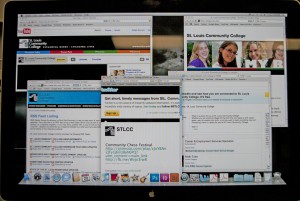STLCC needs to get its social media act together. STLCC has done a good job with creating social media accounts, 16 of them are spread across Facebook, Twitter and YouTube. Its next step should be to create a plan of action with what to do with all of these accounts, or if it even needs them.

Mike Ziegler
– Staff Writer –
![]()
STLCC needs to get its social media act together. STLCC has done a good job with creating social media accounts, 16 of them are spread across Facebook, Twitter and YouTube. Its next step should be to create a plan of action with what to do with all of these accounts, or if it even needs them at all.
While each school should have their own account streaming school specific information, it may be hard keeping voice, tone and strategy consistent.
It may seem like the more the better when it comes to number of accounts, but having so many different outlets can create gaps of users missing vital information rather than filling them. One strong voice is better than many weak ones.
As of March 29, spanning the seven STLCC Facebook accounts 2,679 users clicked “like” on their pages, while the eight twitter accounts accumulated only 707 followers combined. STLCC-Wildwood’s twitter account is linked with its Facebook account, meaning tweets include the first few sentences of the Facebook post with a link to read the rest. Facebook and Twitter need to be treated as separate mediums of communication. What is posted on Facebook isn’t always fit for tweeting on Twitter, and vice versa.
Twitter accounts should also not be used as another form of RSS feed. Linking to the latest news article is not social. Occasionally linking to an article is acceptable, but only tweeting that out and not interacting with your audience defies the social part of social media.
Looking across the various STLCC Twitter and Facebook accounts creates a sense lost focus. There needs to be a plan in place specifying what the college is hoping to accomplish by having an account. Whether it is to handle feedback and questions about the college, or whatever, it needs to incorporate interaction with followers or fans. No one wants to listen to a loudspeaker spouting off the latest news; people want to be part of a conversation.
Foursquare has seen explosive growth over the past year and STLCC has felt the increase. Last year you wouldn’t find many students “checked-in” on campus at Meramec and now at any given time there are around five students. STLCC needs to be where the students are online, and geo-social networks are on the rise.
Foursquare provides tools for businesses and institutions to incorporate Foursquare into their marketing strategy. For example, with the cooperation of Treat America, students could receive a discount, or “special” as foursquare calls them, for checking in at the cafeteria. Tips can be left at venue locations directing students unfamiliar with the campus to notable areas of interest or interesting facts about the institution.
A blog described as students gathering to share their thoughts and experiences at STLCC can be found linked under the social media listings page on STLCC’s website. While blogging can be a powerful and effective tool for sparking conversation, clicking on the about page of the blog shows comments dated from back to last November describing a rabbit being run over and being given to dogs to have fun with. The blog posts are recent, but viewers reading about the dead rabbit would wonder how well the blog is moderated. Comments aren’t necessary and shouldn’t be allowed on an about page.
Under the participation guidelines page, it lists the rules for engagement while commenting on blog posts, but doesn’t list how perspective bloggers can get involved. A lone comment made in February asking how students can get a blog space remains unanswered. A link to sign up in the sidebar only takes you to create your own WordPress blog, not be a contributor to the student blog.
It is clear STLCC wants to play an active part in social media. They just need to focus on the social part of it and maintain a cohesive voice across all outlets, not a scattered one.











